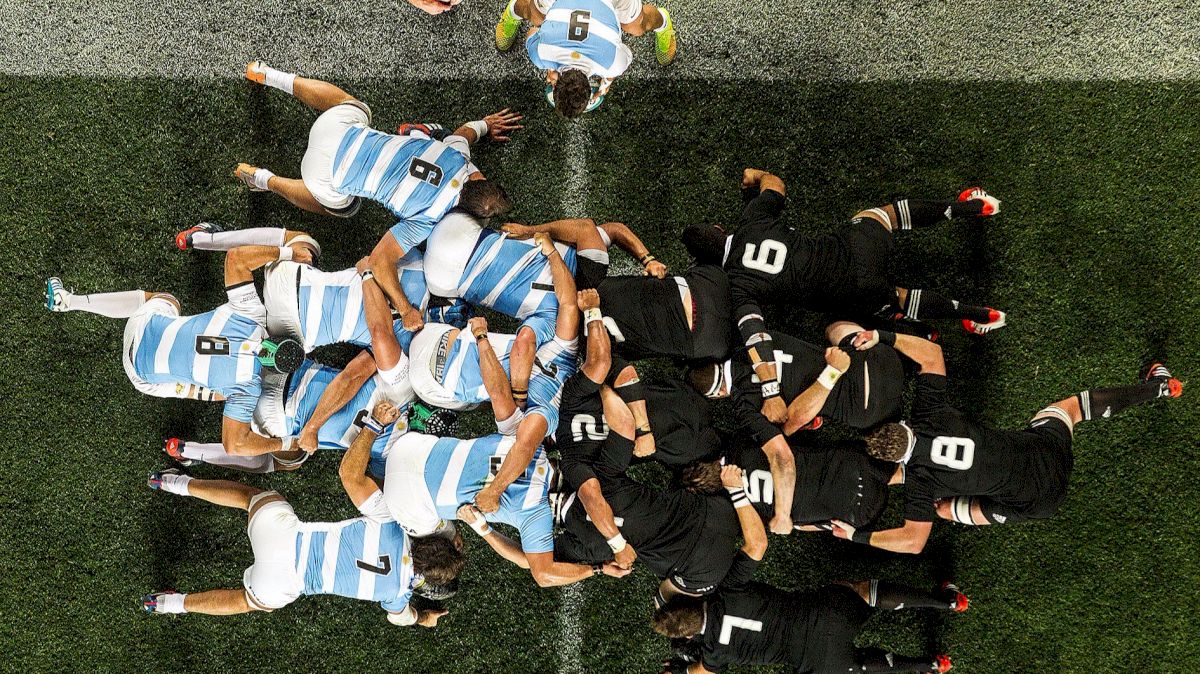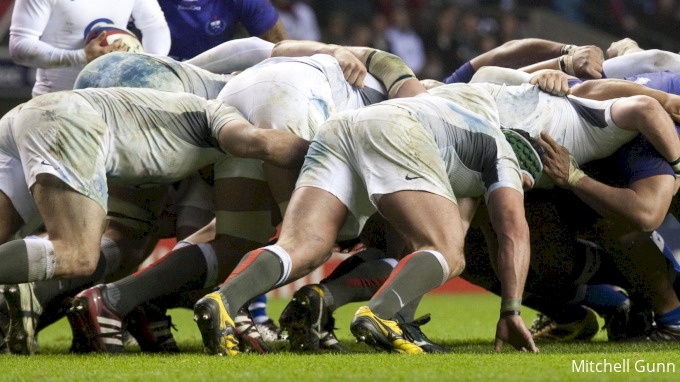Rugby Rules 101: The Scrum
Rugby Rules 101: The Scrum
What does it mean in rugby when someone throws around the term "scrum"? Here we are to fill you in.

What does it mean when someone throws around the terms "lineout" or "scrum"? And no, a scrum is not when a mosh pit of football or basketball players fight for a loose ball. These are specific rugby terms, and they refer to what are known as "set pieces" in a rugby game.
Set pieces are ways to restart the game after a break in play, usually from an infraction like a knock on or a penalty, or when the ball goes out of play. The two most common set pieces are lineouts and scrums, and here is a breakdown of the latter:
The Scrum
Anytime a player fumbles the ball forward, drops the ball forward, or passes it forward, the opposing team gets possession of the ball and gets to perform a scrum. Scrums involve eight players from each team, who bind together and shove against one another.

The shape of the scrum involves three rows; the front row, the second row, and the back row. The front row consists of two props and a hooker, the second row consists of two locks, and the back row consists of two flankers and a No. 8 -- yes the position is called "No. 8".
The team with possession gets to roll the ball into the scrum -- the specific player who rolls the ball in is called the scrum-half. He/she rolls the ball down the tunnel formed by the two teams, and one of the players in the front row, the hooker, attempts to "hook" the ball back with his or her foot towards their team. The ball then rolls its way back through the forest of legs back to the No. 8 at the back of the scrum, and from their the ball is played out and the game resumes.
Here are the laws, according to the World Rugby handbook:
Forming the scrum
- A scrum is formed in the scrum zone at a mark indicated by the referee
- The referee makes the mark to create the middle line of the scrum, which runs parallel to the goal lines
- Teams must be ready to form the scrum within 30 seconds of the mark being made
- When both teams have 15 players, eight players from each team bind together in formation. Each team must have two props and one hooker in the front row and two locks in the second row. Three back-row players from each team complete the scrum
- When a team is reduced to fewer than 15 for any reason, then the number of players in each team in the scrum may be similarly reduced. Where a permitted reduction is made by one team, there is no requirement for the other team to make a similar reduction. However, a team must not have fewer than five players in the scrum
- The players in the scrum bind in the following way:
a.) The props bind to the hooker
b.) The hooker binds with both arms. This can be either over or under the arms of the props
c.) The locks bind with the props immediately in front of them and with each other
d.) All other players in the scrum bind on a lock’s body with at least one arm - The two groups face each other, either side of and parallel to the middle line
- The two front rows stand not more than an arm’s length apart with the hookers at the mark

Engagement at the scrum
- When both sides are square, stable and stationary, the referee calls “crouch”:
a.) The front-rows then adopt a crouched position if they have not already done so. Their heads and shoulders are no lower than their hips, a position that is maintained for the duration of the scrum
b.) The front-rows crouch with their heads to the left of their immediate opponents’, so that no player’s head is touching the neck or shoulders of an opponent - When both sides are square, stable and stationary, the referee calls “bind”:
a.) Each loose-head prop binds by placing the left arm inside the right arm of the opposing tight-head prop
b.) Each tight-head prop binds by placing the right arm outside the left upper arm of the opposing loose-head prop
c.) Each prop binds by gripping the back or side of their opponent’s jersey
d.) All players’ binding is maintained for the duration of the scrum - When both sides are square, stable and stationary, the referee calls “set”
a.) Only then may the teams engage, completing the formation of the scrum and creating a tunnel into which the ball will be thrown
b.) All players must be in position and ready to push forward
c.) Each front-row player must have both their feet on the ground, with their weight firmly on at least one foot
d.) Each hooker’s feet must be in line with, or behind, the foremost foot of that team’s props

During the scrum
- The scrum begins when the ball leaves the hands of the scrum-half
- Only when the scrum begins may the teams push
- Possession may be gained by pushing the opposition backwards and off the ball
- Players may push provided they do so straight and parallel to the ground
- Front-row players may gain possession by striking for the ball but only once the ball touches the ground in the tunnel
- A front-row player striking for the ball may do so with either foot but not both at the same time
Offsides at the scrum
- The six players not involved in the scrum or not the scrum-half from each team must be five meters behind the back foot of the furthest player back on their side of the scrum
- They cannot advance forward until the referee deems that the ball is "out" from the scrum